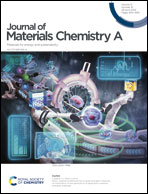Solar-powered plasmon-boosted graphene towards enhanced ammonia production†
Abstract
The urgent need for sustainable and efficient ammonia production has driven intense research towards alternative electrochemical routes. In this study, we present a comprehensive approach that leverages the properties of electrochemically exfoliated nitrogen-doped graphene (NG) combined with titanium nitride (TiN) and metal nanoparticles (NPs) for enhanced electrocatalytic nitrogen reduction reaction (NRR) under mild conditions. The TiN-modified NG nanohybrid demonstrates remarkable light absorption capabilities and a significantly expanded electrochemically active graphene surface, setting the stage for efficient NRR. Further optimization of the NRR is achieved by integrating platinum and ruthenium metal NPs into the TiN/NG structure, forming a PtRu@TiN/NG nanocomposite. Under light exposure, this nanocomposite exhibits an outstanding NH3 productivity of 316 μg h−1 mgcat−1 with a notable 64% faradaic efficiency, surpassing the dark reaction at −1 V which yields 207 μg h−1 mgcat−1. The substitution of N2 with Ar completely halts NH3 generation, emphasizing the essential role of N2 in the NRR process. The exceptional catalytic performance is attributed to the synergistic interplay of Pt–Ru alloying, TiN, and the monolayer of NG, facilitated by their intimate and extensive interfacial contact. While the current yields may not fully meet practical application requirements, this research presents a promising route for ambient NH3 production, emphasizing the potential for further advancements in active materials and reaction design to enhance ammonia synthesis.



 Please wait while we load your content...
Please wait while we load your content...